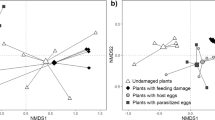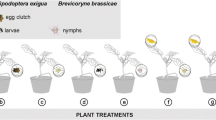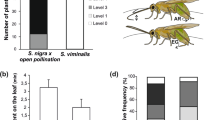Abstract
Earlier investigations of host habitat location in the egg parasitoid Oomyzus gallerucae have shown that oviposition of the elm leaf beetle (Xanthogaleruca luteola) induces the field elm (Ulmus minor) to emit volatiles that attract the egg parasitoid. In this study we investigated the mechanism of this induction by testing the effects of differently treated elm leaves on O. gallerucae in a four-arm olfactometer. First we investigated which sequence of the herbivore oviposition behavior is necessary for the synomone induction. The following major sequences were observed: (1) Prior oviposition, the gravid female gnawed shallow grooves into the leaf surface. (2) After gnawing upon the leaf surface, the female attached about 20–30 eggs with oviduct secretion in the grooves. We experimentally mimicked the shallow grooves on the leaf surface by scratching the leaf surface with a scalpel (= scratched leaves). Volatiles from such scratched leaves did not attract the egg parasitoid. However, as soon as eggs with oviduct secretion, or only oviduct secretion, was applied to these scratched leaves, they emitted attractive volatiles. Application of oviduct secretion and eggs on undamaged leaves did not elicit release of attractive synomones. Thus, an elicitor is located in the oviduct secretion, but becomes active only when the leaf surface is damaged. Jasmonic acid is known as a mediator of plant responses induced by feeding of herbivorous arthropods, and we demonstrate that it mediates production of elm synomones that attract O. gallerucae. The plant's reaction to oviposition was systemic, and leaves without eggs near leaves with eggs emitted attractants.
Similar content being viewed by others
REFERENCES
Agelopoulos,Ñ N.ÑG.,ÑandÑ Keller,Ñ M.ÑA.Ñ1994a.ÑPlant-naturalÑenemyÑassociationÑinÑtritrophicÑsystem,ÑCotesiaÑrubecola-PierisÑrapae-BrassicaceaeÑ(Cruciferae).ÑI.ÑSourcesÑofÑinfochemicals.ÑJ.ÑChem.ÑEcol.Ñ20:1725–1734.
Agelopoulos,Ñ N.ÑG.,ÑandÑ Keller,Ñ M.ÑA.Ñ1994b.ÑPlant-naturalÑenemyÑassociationÑinÑtritrophicÑsystem,ÑCotesiaÑrubecola-PierisÑrapae-BrassicaceaeÑ(Cruciferae).ÑII.ÑPreferenceÑofÑC.ÑrubecolaÑforÑlandingÑandÑsearching.ÑJ.ÑChem.ÑEcol.Ñ20:1735–1748.
Alborn,Ñ H.ÑT.,Ñ Turlings,Ñ T.ÑC.ÑJ.,Ñ Jones,Ñ T.ÑH.,ÑStenhagen,Ñ G.,Ñ Loughrin,Ñ J.ÑH.,ÑandÑ Tumlinson,Ñ J.ÑH.Ñ1997.ÑAnÑelicitorÑofÑplantÑvolatilesÑfromÑbeetÑarmywormÑoralÑsecretion.ÑScienceÑ276:945–949.
Baldwin,Ñ I.ÑT.Ñ1988.ÑTheÑalkaloidal-responsesÑofÑwildÑtobaccoÑtoÑrealÑandÑsimulatedÑherbivory.ÑOecologiaÑ77:378–381.
Baldwin,Ñ I.ÑT.Ñ1991.ÑDamage-inducedÑalkaloidsÑinÑwildÑtobacco,Ñpp.Ñ47–69,ÑinÑD.ÑW.Ñ TallamyÑandÑ M.ÑJ.Ñ RauppÑ(eds.).ÑPhytochemicalÑInductionÑbyÑHerbivores.ÑJohnÑWiley,Ñ NewÑYork.
Baldwin,Ñ I.ÑT.Ñ1996.ÑMethyljasmonate-inducedÑnicotineÑproductionÑinÑNicotianaÑattenuata:ÑInducingÑdefenseÑinÑtheÑfieldÑwithoutÑwounding.ÑEntomol.ÑExp.ÑAppl.Ñ80:213–220.
Bodnaryk,Ñ R.ÑP.Ñ1994.ÑPotentÑeffectÑofÑjasmonatesÑonÑindoleÑglucosinolatesÑinÑoilseedÑrapeÑandÑmustard.ÑPhytochemistryÑ35:301–305.
Boland,Ñ W.ÑJ.,Ñ Hopke,Ñ J.,Ñ Donath,Ñ J.,Ñ NÜske,Ñ J.,ÑandÑ Bublitz,Ñ F.Ñ1995.ÑJasmonicÑacidÑandÑcoronatineÑinduceÑodorÑproductionÑinÑplants.ÑAngew.ÑChem.ÑInt.ÑEd.ÑEngl.Ñ34:1600–1602.
Bortz,Ñ J.Ñ1993.ÑStatistikÑfürÑSozialwissenschaftler.Ñ4thÑed.ÑSpringer.Ñ Berlin.ÑHeidelberg,ÑNewÑYork.
Creelman,Ñ R.ÑA.,ÑandÑ Mullet,Ñ J.ÑE.Ñ1997.ÑBiosynthesisÑandÑactionÑofÑjasmonatesÑinÑplants.ÑAnnu.ÑRev.ÑPlantÑPhysiol.ÑPlantÑMol.ÑBiol.Ñ48:355–381.
DeÑMoraes,Ñ C.ÑM.,Ñ Lewis,Ñ W.ÑJ.,Ñ ParĚ,Ñ P.ÑW.,Ñ Alborn,Ñ H.ÑT.,ÑandÑ Tumlinson,Ñ J.ÑH.Ñ1998.ÑHerbivore-infestedÑplantsÑselectivelyÑattractÑparasitoids.ÑNatureÑ393:570–573.
Dicke,Ñ M.Ñ1994.ÑLocalÑandÑsystemicÑproductionÑofÑvolatileÑherbivore-inducedÑterpenoids:ÑTheirÑroleÑinÑplant-carnivoreÑmutualism.ÑJ.ÑPlantÑPhysiol.Ñ143:465–472.
Dicke,Ñ M.,ÑandÑ Sabelis,Ñ M.ÑW.Ñ1988.ÑHowÑplantsÑobtainÑpredatoryÑmitesÑasÑbodyguards.ÑNeth.ÑJ.ÑZool.Ñ38:148–165.
Dicke,Ñ M.,Ñ Sabelis,Ñ M.,Ñ Sabelis,Ñ M.ÑW.,Ñ Takabayashi,Ñ J.,Ñ Bruin,Ñ J.,ÑandÑ Posthumus,Ñ M.ÑA.Ñ1990a.ÑPlantÑstrategiesÑofÑmanipulatingÑpredator-preyÑinteractionsÑthroughÑallelochemicals:ÑProspectsÑforÑapplicationÑinÑpestÑcontrol.ÑJ.ÑChem.ÑEcol.Ñ16:3091–3118.
Dicke,Ñ M.,Ñ VanÑBeek,Ñ T.ÑA.,Ñ Posthumus,Ñ M.ÑA.,ÑBenÑDom,Ñ N.,Ñ VanÑBokhoven,Ñ H.,ÑandÑ DeÑGroot,Ñ A.Ñ1990b.ÑIsolationÑandÑidentificationÑofÑvolatileÑkairomoneÑthatÑaffectsÑpredator-preyÑinteractions.ÑInvolvementÑinÑhostÑplantÑinÑitsÑproduction.ÑJ.ÑChem.ÑEcol.Ñ16:381–396.
Du,Ñ Y.,Ñ Poppy,Ñ G.ÑM.,ÑandÑ Powell,Ñ W.Ñ1996.ÑRelativeÑimportanceÑofÑsemiochemicalsÑfromÑfirstÑandÑsecondÑtrophicÑlevelsÑinÑhostÑforagingÑbehaviorÑofÑAphidiusÑervi.ÑJ.ÑChem.ÑEcol.Ñ22:1591–1605.
Du,Ñ Y.,Ñ Poppy,Ñ G.ÑM.,Ñ Powell,Ñ W.,Ñ Picket,Ñ J.ÑA.,Ñ Wadhams,Ñ L.ÑJ.,ÑandÑ Woodcock,Ñ C.ÑM.Ñ1998.ÑIdentificationÑofÑsemiochemicalsÑreleasedÑduringÑaphidÑfeedingÑthatÑattractÑparasitoidÑAphidiusÑervi.ÑJ.ÑChem.ÑEcol.Ñ24:1355–1368.
Farmer,Ñ E.ÑE.,ÑandÑ Ryan,Ñ C.ÑA.Ñ1992.ÑOctadecanoidÑprecursorsÑofÑjasmonicÑacidÑactivateÑtheÑsynthesisÑofÑwound-inducibleÑproteinaseÑinhibitors.ÑPlantÑCellÑ4:129–134.
Hopke,Ñ J.,Ñ Donath,Ñ J.,Ñ Blechert,Ñ S.,ÑandÑ Boland,Ñ W.Ñ1994.ÑHerbivore-inducedÑvolatiles:ÑtheÑemissionÑofÑacylicÑhomoterpenesÑfromÑleavesÑofÑPhaseolusÑlunatusÑandÑZeaÑmaysÑcanÑbeÑtriggeredÑbyÑaÑβ-glucosidaseÑandÑjasmonicÑacid.ÑFEBSÑLett.Ñ352:146–150.
Karban,Ñ R.,ÑandÑ Baldwin,Ñ I.Ñ1997.ÑInducedÑResponsesÑtoÑHerbivory.ÑTheÑUniversityÑofÑChicagoÑPress,Ñ Chicago,Ñ319Ñpp.
Mattiacci,Ñ L.,Ñ Dicke,Ñ M.,ÑandÑ Posthumus,Ñ M.ÑA.Ñ1994.ÑInductionÑofÑparasitoidÑattractingÑsynomoneÑinÑBrusselsÑsproutsÑplantsÑbyÑfeedingÑofÑPierisÑbrassicaeÑlarvae:ÑRoleÑofÑmechanicalÑdamageÑandÑherbivoreÑelicitor.ÑJ.ÑChem.ÑEcol.Ñ20:2229–2247.
Mattiacci,Ñ L.,Ñ Dicke,Ñ M.,ÑandÑ Posthumus,Ñ M.ÑA.Ñ1995.Ñβ-Glucosidase:ÑAnÑelicitorÑofÑherbivoreÑinducedÑplantÑodorÑthatÑattractsÑhost-searchingÑparasiticÑwasps.ÑProc.ÑNatl.ÑAcad.ÑSci.ÑU.S.A.Ñ92:2036–2040.
McCall,Ñ P.ÑJ.,Ñ Turlings,Ñ T.ÑC.ÑJ.,Ñ Lewis,Ñ W.ÑJ.,ÑandÑTumlinson,Ñ J.ÑH.Ñ1994.ÑRoleÑofÑplantÑvolatilesÑinÑhostÑlocationÑbyÑtheÑspecialistÑparasitoidÑMicroplitisÑcroceipesÑCressonÑ(Braconidae:ÑHymenoptera).ÑJ.ÑInsectÑBehav.Ñ6:625–639.
Meiners,Ñ T.,ÑandÑ Hilker,Ñ M.Ñ1997.ÑHostÑlocationÑinÑOomyzusÑgallerucaeÑ(Hymenoptera:ÑEulophidae),ÑanÑeggÑparasitoidÑofÑtheÑelmÑleafÑbeetleÑXanthogalerucaÑluteolaÑ(Coleoptera:ÑChrysomelidae).ÑOecologiaÑ112:87–93.
Miksch,Ñ M.,ÑandÑ Boland,Ñ W.Ñ1996.ÑAirborneÑmethyljasmonateÑstimulatesÑtheÑbiosynthesisÑofÑfuranocoumarinsÑinÑtheÑleavesÑofÑceleryÑplantsÑ(ApiumÑgraveolescens).ÑExperientiaÑ52:739–743.
ParĚ,Ñ P.ÑW.,ÑandÑ Tumlinson,Ñ J.ÑH.Ñ1998.ÑCottonÑvolatilesÑsynthesizedÑandÑreleasedÑdistalÑtoÑtheÑsiteÑofÑinsectÑdamage.ÑPhytochemistryÑ47:521–526.
RÖse,Ñ U.ÑS.ÑR.,Ñ Manukian,Ñ A.,Ñ Heath,Ñ R.ÑR.,ÑandÑ Tumlinson,Ñ J.ÑH.Ñ1996.ÑVolatileÑsemiochemicalsÑreleasedÑfromÑundamagedÑcottonÑleaves.ÑAÑsystemicÑresponseÑofÑlivingÑplantsÑtoÑcaterpillarÑdamage.ÑPlantÑPhysiol.Ñ111:887–895.
Steinberg,Ñ S.,Ñ Dicke,ÑM.,ÑandÑ Vet,Ñ L.ÑE.ÑM.Ñ1993.ÑRelativeÑimportanceÑofÑinfochemicalsÑfromÑfirstÑandÑsecondÑtrophicÑlevelÑinÑlong-rangeÑhostÑlocationÑbyÑtheÑlarvalÑparasitoidÑCotesiaÑglomerata.ÑJ.ÑChem.ÑEcol.Ñ19:47–59.
Sticher,Ñ L.,Ñ Mauch-Mani,Ñ B.,ÑandÑ MĚtraux,Ñ J.ÑP.Ñ1997.ÑSystemicÑacquiredÑresistance.ÑAnnu.ÑRev.ÑPhytopathol.Ñ35:235–270.
Takabayashi,Ñ J.,Ñ Dicke,Ñ M.,ÑandÑ Posthumus,Ñ M.ÑA.Ñ1994.ÑVolatileÑherbivore-inducedÑterpenoidsÑinÑplant-miteÑinteractions:ÑVariationÑcausedÑbyÑbioticÑandÑabioticÑfactors.ÑJ.ÑChem.ÑEcol.Ñ20:1329–1354.
Tallamy,Ñ D.ÑW.Ñ1985.ÑSquashÑbeetleÑfeedingÑbehavior:ÑAnÑadaptationÑagainstÑcucurbitÑdefenses.ÑEcologyÑ66:1574–1579.
Turlings,Ñ T.ÑC.ÑJ.,ÑandÑ Benrey,Ñ B.Ñ1998.ÑEffectsÑofÑplantÑmetabolitesÑonÑtheÑbehaviorÑandÑdevelopmentÑofÑparasiticÑwasps.ÑEcoscienceÑ5:321–333.
Turlings,Ñ T.ÑC.ÑJ.,Ñ Tumlinson,Ñ J.ÑH.,ÑandÑLewis,Ñ W.ÑJ.Ñ1990.ÑExploitationÑofÑherbivore-inducedÑplantÑodorsÑbyÑhostÑseekingÑparasiticÑwasps.ÑScienceÑ250:1251–1253.
Turlings,Ñ T.ÑC.ÑJ.,Ñ Tumlinson,Ñ J.ÑH.,Ñ Eller,Ñ F.ÑJ.,ÑandÑLewis,Ñ W.ÑJ.Ñ1991.ÑLarval-damagedÑplants:ÑsourceÑofÑvolatileÑsynomonesÑthatÑguideÑtheÑparasitoidÑCotesiaÑmarginiventrisÑtoÑtheÑmicrohabitatÑofÑitsÑhost.ÑEntomol.ÑExp.ÑAppl.Ñ58:72–85.
Turlings,Ñ T.ÑC.ÑJ.,Ñ McCall,Ñ P.ÑJ.,Ñ Alborn,Ñ H.ÑT.,ÑandÑTumlinson,Ñ J.ÑH.Ñ1993.ÑAnÑelicitorÑinÑcaterpillarÑoralÑsecretionsÑthatÑinducesÑcornÑseedlingsÑtoÑemitÑchemicalÑsignalsÑattractiveÑtoÑparasiticÑwasps.ÑJ.ÑChem.ÑEcol.Ñ19:412–425.
Turlings,Ñ T.ÑC.ÑJ.,Ñ Loughrin,Ñ J.ÑH.,Ñ McCall,Ñ P.ÑJ.,Ñ RÖse,Ñ U.ÑS.ÑR.,Ñ Lewis,Ñ W.ÑJ.,ÑandÑ Tumlinson,Ñ J.ÑH.Ñ1995.ÑHowÑcaterpillar-damagedÑplantsÑprotectÑthemselvesÑbyÑattractingÑparasiticÑwasps.ÑProc.ÑNatl.ÑAcad.ÑSci.ÑU.S.A.Ñ92:4169–4174.
Turlings,Ñ T.ÑC.ÑJ.,Ñ Bernasconi,Ñ M.,Ñ Bertossa,Ñ R.,Ñ Bigler,Ñ F.,Ñ Caloz,Ñ G.,ÑandÑ Dorn,Ñ S.Ñ1998.ÑTheÑinductionÑofÑvolatileÑemissionsÑinÑmaizeÑbyÑthreeÑherbivoreÑspeciesÑwithÑdifferentÑfeedingÑhabits:ÑpossibleÑconsequencesÑforÑtheirÑnaturalÑenemies.ÑBiol.ÑControlÑ11:122–129.
Vet,Ñ L.ÑE.ÑM.,Ñ Lenteren,Ñ J.ÑC.,Ñ VanÑHeymanns,Ñ M.,ÑandÑ Meelis,Ñ E.Ñ1983.ÑAnÑairflowÑolfactometerÑforÑmeasuringÑolfactoryÑresponsesÑofÑhymenopterousÑparasitoidsÑandÑotherÑsmallÑinsects.ÑPhysiol.ÑEntomol.Ñ8:97–106.
Author information
Authors and Affiliations
Rights and permissions
About this article
Cite this article
Meiners, T., Hilker, M. Induction of Plant Synomones by Oviposition of a Phytophagous Insect. J Chem Ecol 26, 221–232 (2000). https://doi.org/10.1023/A:1005453830961
Issue Date:
DOI: https://doi.org/10.1023/A:1005453830961




